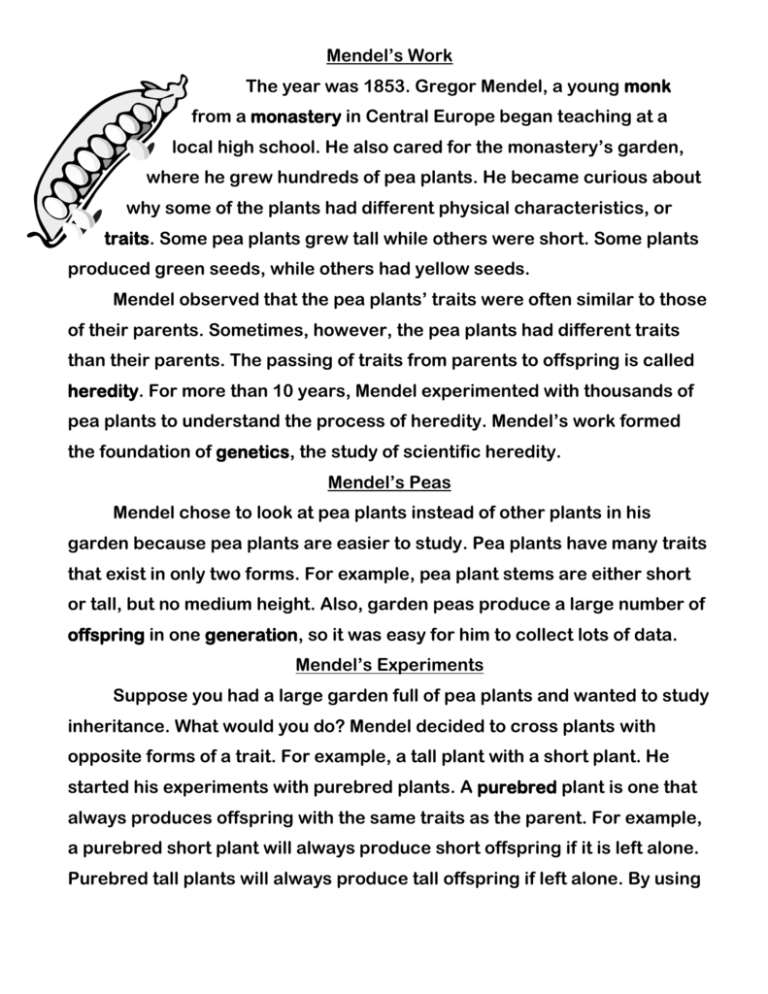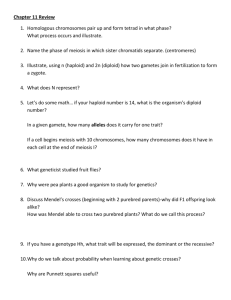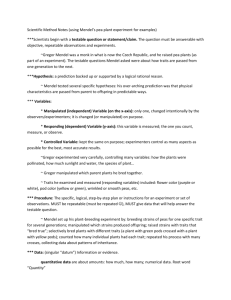Mendel`s Work
advertisement

Mendel’s Work The year was 1853. Gregor Mendel, a young monk from a monastery in Central Europe began teaching at a local high school. He also cared for the monastery’s garden, where he grew hundreds of pea plants. He became curious about why some of the plants had different physical characteristics, or traits. Some pea plants grew tall while others were short. Some plants produced green seeds, while others had yellow seeds. Mendel observed that the pea plants’ traits were often similar to those of their parents. Sometimes, however, the pea plants had different traits than their parents. The passing of traits from parents to offspring is called heredity. For more than 10 years, Mendel experimented with thousands of pea plants to understand the process of heredity. Mendel’s work formed the foundation of genetics, the study of scientific heredity. Mendel’s Peas Mendel chose to look at pea plants instead of other plants in his garden because pea plants are easier to study. Pea plants have many traits that exist in only two forms. For example, pea plant stems are either short or tall, but no medium height. Also, garden peas produce a large number of offspring in one generation, so it was easy for him to collect lots of data. Mendel’s Experiments Suppose you had a large garden full of pea plants and wanted to study inheritance. What would you do? Mendel decided to cross plants with opposite forms of a trait. For example, a tall plant with a short plant. He started his experiments with purebred plants. A purebred plant is one that always produces offspring with the same traits as the parent. For example, a purebred short plant will always produce short offspring if it is left alone. Purebred tall plants will always produce tall offspring if left alone. By using purebred plants, Mendel knew that the offspring’s traits will always be identical to that of the parents. In his first experiment, Mendel crossed purebred tall plants with purebred short plants. He called these parent plants the parental generation, or P generation. He called the offspring from this first cross the first filial generation, or the F1 generation. The word filial means “son” in Latin. You can see the results of Mendel’s first cross in Figure 1 below. To Mendel’s surprise, all of the offspring in the F1 generation were tall. Even though one parent was short, none of the offspring were short. The shortness had disappeared! Mendel let the plants in the F1 generation grow and reproduce with themselves and was again surprised with the results. The plants in the new F2 (second filial) generation were a mix of tall and short plants. This occurred even though none of the F1 parents were short! The shortness trait reappeared!! Mendel counted the number of tall and short plants in the F2 generation. He found that ¾ of the plants were tall, while ¼ of the plants were short. Other Traits In addition to stem height, Mendel also studied six other traits in his peas: seed shape, seed color, seed coat color, pod shape, pod color, and flower position. Mendel crossed plants with these traits the same way as he did for stem height. The results for each experiment were similar to those that he observed for stem height. Only one form of the trait appeared in the F1 generation. However, in the F2 generation the “lost” form of the trait always reappeared in about ¼ of the plants. Dominant and Recessive Alleles From his results, Mendel reasoned that individual factors must control the inheritance of traits in peas. The factors that control each trait exist in pairs. The female contributes one factor, while the male parent contributes the other factor. Mendel went on to figure out that one factor in a pair can mask, or hide, the other. The factor for tallness, for example, masked the factor for shortness in the F1 generation, causing only tall plants to be present. Today, scientists call these factors that control traits genes. They call the different forms of a gene alleles. The allele that is able to mask the other traits is called dominant and the allele that can be masked is called recessive.







